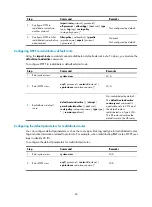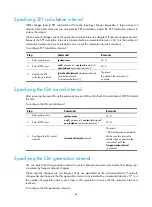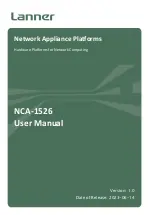
77
Step Command
Remarks
3.
Configure the OSPF network
type for the interface as
broadcast.
ospf network-type broadcast
By default, the network type of an
interface depends on the link layer
protocol.
4.
Configure a router priority for
the interface.
ospf dr-priority
priority
Optional.
The default router priority is 1.
Configuring the NBMA network type for an interface
After configuring the network type of an interface as NBMA, you must make some special configurations.
Because NBMA interfaces cannot find neighbors via broadcasting hello packets, you must specify
neighbors and their router priorities. (A router priority
of 0 means the router does not have the DR election
right. A router priority greater than 0 means the router has the DR election right.)
The router priority configured with the
ospf dr-priority
command is for actual DR election. The priority
configured with the
peer
command indicates whether a neighbor has the election right or not. If you
configure the router priority for a neighbor as 0, the local router will assume the neighbor has no election
right, and thus send no hello packets to this neighbor. However, if the local router is the DR or BDR, it still
sends hello packets to the neighbor with priority 0 for neighborship establishment.
To configure the OSPF network type for an Interface as NBMA:
Step Command
Remarks
1.
Enter system view.
system-view
N/A
2.
Enter interface view.
interface
interface-type
interface-number
N/A
3.
Configure the OSPF network
type for the interface as
NBMA.
ospf network-type nbma
By default, the network type of an
interface depends on the link layer
protocol.
4.
Configure a router priority
for the interface.
ospf dr-priority
priority
Optional.
The default router priority is 1.
5.
Exit to system view.
quit
N/A
6.
Enter OSPF view.
ospf
[
process-id
|
router-id
router-id
|
vpn-instance
vpn-instance-name
] *
N/A
7.
Specify a neighbor and its
router priority.
peer
ip-address
[
cost
value
|
dr-priority
dr-priority
]
N/A
Configuring the P2MP network type for an interface
Step Command
Remarks
1.
Enter system view.
system-view
N/A
















































